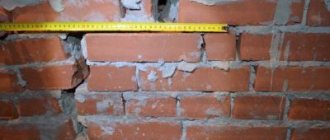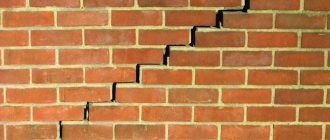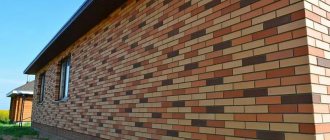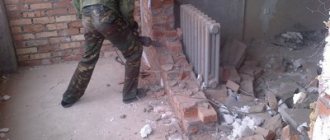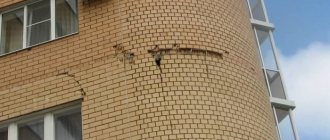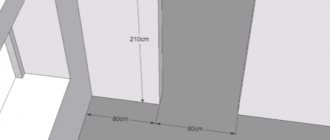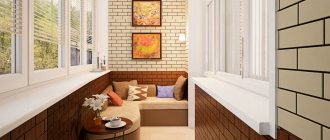Brickwork is one of the most reliable and durable options for building walls. But even in the highest quality structures, due to the influence of various factors, defects and damage appear over time.
The most common and frequent defects in brickwork on external walls are cracks, tears, delaminations and others. If any defect occurs, brick walls lose their original characteristics and need to be repaired.
Defects in brickwork and ways to eliminate them
The main defects of brickwork are cracks, destruction of masonry mortar joints, delamination of rows, destruction of individual bricks, deformation of walls in the form of their bulging and deviation from the vertical.
Repairing cracks in brickwork
Sealing cracks begins with cleaning the surface from dust, dirt, and remnants of collapsed masonry mortar. For cleaning you can use brushes, hand grinders, or compressed air. The surfaces are then washed with water from a spray bottle or manually using a brush. Small single cracks can simply be covered with mortar. Wide cracks in the masonry are filled with mortar.
The edges of the cracks should first be cut into a cone for better filling with cement mortar. If the crack width is more than 4-5 mm, then it is necessary to partially rebuild the masonry. And to reliably connect the main wall with the newly re-laid one, you need to lay anchor ties, that is, several reinforcement bars, or just a steel beam.
Replacing bricks in masonry
Destroyed bricks must be replaced. In one limited area, no more than four bricks that have become unusable can be replaced at the same time
The bricks to be replaced are carefully broken into small pieces using a hammer drill or an ordinary chisel and removed.
In the resulting gap, all adjacent solid bricks are freed from the remnants of the old mortar and moistened with water. New bricks are placed in water until all air bubbles are released from them. Mortar is applied to all the old bricks in the gap, as well as to the prepared new bricks. They are carefully inserted into the gap and aligned with adjacent bricks. The seams are filled with mortar for jointing.
Repair of brickwork seams
Repair of seams begins with the removal of old collapsed mortar. For this purpose, use a chisel, a hammer, or a metal brush. Along the entire length of all seams, both vertical and horizontal, grooves up to 15 mm deep are made to better secure the new mortar. The prepared seams are moistened with water from a spray bottle or using a brush.
To fill the seams with mortar, a small wooden shield with a handle, called a falcon, is used, as well as a cutting tool, that is, a narrow trowel with flat side edges. A small amount of mortar is applied to the upper surface of the falcon, and the falcon is leaned against the wall so that its upper surface coincides with the lower edge of the seam. By cutting, the solution is moved into the seam, filling it evenly. The solution is applied from bottom to top and from left to right.
Deformations of brick walls
Before you begin to eliminate the deformation of brick walls, you need to find out its causes. Perhaps, first, it will be necessary to strengthen the foundation, eliminate the causes of its subsidence, including repairing the main water pipelines passing nearby, organizing groundwater drainage, and the like.
It is also very important to check the condition of internal connections in the structures of buildings erected using the brick masonry method for the presence of breaks or their complete absence, the presence of displacements on supports, beams, purlins, floor slabs, and the presence of unacceptable loads on the masonry.
Deformation of brick walls is detected by a visual method, measurements and verification calculations of loads on brick wall structures. They are eliminated by completely or partially dismantling and re-lining the walls with reinforcement according to calculations. Brick walls can be strengthened using clips, which will prevent the brickwork from deforming. They can be steel, reinforced concrete, composite and reinforced.
Currently, a new method of strengthening brickwork has been developed and is being used, in which polymer cement mortar is used instead of masonry cement mortar. This method allows you to increase the load-bearing capacity of brickwork by 60% without increasing its mass.
Proper care of brickwork and timely repairs can increase the service life of brick walls for a long time.
If you liked the article, tell your friends about it:
Installation of reinforced concrete belts
Reinforcement of the surface with a reinforced concrete cage is carried out by fixing it around the entire perimeter - in this way a reinforcing mesh is formed.
This method of restoring brick walls is characterized by significant cost savings. It is carried out in a short time, but during its construction the pressure of the mass on the base increases noticeably
When using a reinforced concrete structure, it is important to take into account technical indications such as:
The reinforced concrete frame is attached with clamps to the brick wall along the entire perimeter, forming a reinforcing mesh.
- The clip is 4-12 cm thick.
- Fine-grained concrete mortar of at least class 10.
- Longitudinal fittings type A240-A400/AI, AII, AIII class.
- Transverse reinforcement A240/AI class, distance no more than 15 cm.
Reinforcing the surface with a reinforced concrete layer is associated with fastening the reinforcing mesh along the entire base; it should be secured with special latches. To restore the integrity of the wall, a kind of shell with a very strong coating is created. The result of its impact is determined by the condition of the masonry itself, the strength of the concrete coating, and the percentage of surface reinforcement. This design is able to take on a small share of the load, thereby facilitating the laying.
Small layers of the clip are fixed to the surface, after which the base is plastered. High layers are organized using formwork and strengthened along the entire height.
Installation of a composite clip is also used.
The steel structure compresses the masonry on both sides, thereby increasing its level of resistance.
The use of composite raw materials gives the best results for strengthening the brick surface. The raw materials are based on strong fibers and glass fiber materials are used. They increase the compressive and shear strength of structures. The prepared brick is treated with mortar and then primed. Then the metal frames are attached and temporary fastenings are removed, the walls are painted and plastered.
If walls are reinforced with steel structures, then the steel frame is a metal device that significantly increases the main purpose of the surfaces.
To build such a structure, reinforcement bars d up to 12 mm or steel clamps are used; they are welded to the corners. They are placed in the solution at corner points to strengthen the area. Such elements are located at a distance of 500 mm. The steel corners are covered with a metal mesh on top. For large volumes of work, a mortar pump is used.
The brick can be strengthened when the matter is brought to its logical conclusion, which will cause the damage to resume. It is necessary to carry out reconstruction in a timely manner, which will prevent the walls from collapsing. The considered methods for strengthening brick surfaces make it possible to increase the stability of the device to loads, deformations and factors of seismological significance.
Removing cracks
removing cracks in a brick wall
External walls in houses or other buildings tend to crack. This phenomenon is quite common. Do-it-yourself restoration of brickwork is carried out after the reasons for the formation of cracks have been determined. There is one proven method for conducting this event. Special beacons made of plain paper or lintels made of plaster are installed on the wall (the plaster has been previously removed).
The wall should be left in this state for about two weeks, after which it will become clear whether the crack is growing or not. The presence or absence of installed beacons will serve as indicators of a problem. If everything remains in place, you can safely begin such a task as restoration of brickwork, the price of which is determined by the need to purchase a certain amount of building material.
The cement mortar may also contain adhesive components. This composition is used to eliminate large cracks. To eliminate smaller defects, the solution must be liquid.
It is worth emphasizing that during the restoration of brickwork, cement mortar is poured into the crack using a kind of construction syringe
restoration of old masonry
Restoring old brickwork is sometimes full of surprises. A more serious problem is the spalling of brickwork, which indicates the poor quality of the bricks. After only a short period of time, small cracks become apparent on the surface, but through them moisture gets inside, which has a destructive effect. Even a slight difference in temperature conditions gives impetus to further growth of the crack. As a result of the negative impact of such factors, complete cracking of the brick occurs.
In order not to disturb the overall architecture, restoration of brickwork must be carried out promptly and with the utmost care. A brick that has begun to crumble should be removed from the wall.
Depending on the degree of destruction, it may be necessary to remove the nearest bricks located in the neighborhood
In this case, you should pay attention to good bricks and leave them in place without damaging them. After removing the damaged elements, the surface should be cleaned of dust and old mortar, and a new brick should be installed in the free space.
In this case, the solution must be of good quality. To add aesthetics, it is recommended to make decorative plaster to look like brick.
When carrying out repairs on a large section of the wall, it is important to use special supports made of metal. First, metal jumpers are placed on the wall, and then the racks are placed
Jack stands are often used. Although the possibility of using massive logs or beams is not excluded.
The prices for restoration of brickwork are very high. Not every specialist can undertake this work.
It is important to have special skills
Stages of deformation of brickwork
- Tension in the structure that does not entail damage to the masonry.
- The appearance of minor cracking in some bricks, so-called hairline cracking.
- Connection of several clefts with vertical seams. This contributes to the delamination of the masonry.
- Gradual deformation of the base of the wall.
Already at the first signs of such manifestations, it is important to understand the reasons and monitor the quality indicators of the laid brick. It is necessary to monitor the binding of external walls, the height of the seams, maintaining a horizontal base and filling these gaps with the composition
Why is it important to carry out inspection and restoration on time?
If defects are not repaired in a timely manner, then in the future problems may arise not only with the seams, but with the building as a whole.
Failure to repair defects will result in failure of the sealing of the brickwork. This also contributes to heat loss in the building and leads to a lack of protection of the building from moisture.
The service life of brickwork is reduced, small cracks appear and sound insulation is impaired. In addition, the appearance of the building's façade is greatly deteriorated.
Crack inspection
Depending on the stress state of the masonry, four stages of its work are distinguished. The first stage is a state of stress that does not create damage in the masonry; the second stage - the appearance of minor hairline cracks in individual bricks; third stage - with increasing load, the cracks, uniting with each other and with vertical seams, delaminate the masonry into separate seams; fourth stage - destruction of masonry
In this regard, it is very important to establish the causes of cracks in the masonry already in the first two stages. Cracks are identified by visual inspection of surfaces, as well as selective removal of protective or finishing coatings from structures
It is necessary to determine the position, shape, direction of spread along the length, width of the opening, depth, age, and also determine whether their development continues or has stopped.
A visual inspection consists of inspecting cracks. Highly located cracks are examined through binoculars. A clean fracture surface indicates a recent origin of the crack, a contaminated surface indicates a long-term origin.
Particular attention should be paid to identifying cracks that coincide with the seams of the brickwork, as they are quite difficult to detect
To determine the opening and depth of cracks, there are currently a number of instruments, of which the most convenient in the field is a set of probes, preferably needle-type (or templates with strokes of appropriate thickness), as well as more complex instruments - crack gauges and crack gauges (Fig. 2 ).
Rice. 2. Mechanical gap gauge three-axis (a) and string (b)
Important indicators are the time of appearance of cracks and external circumstances that could be the reasons for the deformation of the building. The picture of wall damage becomes significantly more complicated when cracks occur from different causes and at different times, so to analyze them it is necessary to have materials on engineering geological conditions, the history of design, construction and operation of the building, and the location of underground networks.
The results of crack inspections must be presented clearly. Cracks are applied to diagrams of facades, interior walls, and wall layouts.
For clarity, the diagram can be made in axonometry. The cracks are numbered, their length and dimensions (opening width, depth) are indicated, their beginning at a given point in time is noted, and the locations and numbers of the attached photographs are indicated. During long-term observations, deformation marks (beacons) are installed in the place of greatest crack development.
The lighthouse is a plate 200...250 mm long, 40...50 mm wide and 6...10 mm high, placed across the crack (Fig. 3). The preferred lighthouse material is gypsum or cement-sand mortar.
Rice. 3. Gypsum lighthouse
Two glass or metal plates, each fixed at one end on different sides of the crack, or a lever system, are also used as a beacon. The rupture of the beacon or the displacement of the plates relative to each other indicates the development of deformations. In dry rooms it is allowed to install beacons made of paper strips.
The lighthouse is installed on the main material of the wall, having first removed the plaster from its surface.
It is recommended to place beacons also in a pre-cut groove. In this case, the hole is filled with gypsum or cement-sand mortar.
The location of the cracks is schematically plotted on the wall layout diagram, noting the numbers and date of installation of the beacons.
Beacons are inspected a week after their installation, and then at least once a month. In case of intense cracking, daily monitoring is required. When observing the development of a crack along its length, the ends of the crack are fixed with transverse strokes during each inspection. The date of inspection is indicated next to each stroke. The observation log records the number and date of installation of the beacon, the location and layout, the initial width of the crack, and changes in the length and depth of the crack over time. If the beacon is deformed, a new one is installed next to it, which is assigned the same number, but with an index. Lighthouses on which cracks have appeared are not removed until the end of observations.
If no change in the size of the cracks is detected within 30 days, their development can be considered complete, the beacons can be removed and the cracks can be repaired.
increasing the load-bearing capacity and repairing brick walls
The processes of restoring and increasing the load-bearing capacity of brick walls, as well as repairing walls using traditional methods (reinforced concrete jackets, frames, etc.) are associated with a number of problems caused by the need for underlying structures and foundations to absorb additional loads from the mass of reinforcing elements introduced into the structure reinforced concrete layers. Thus, when installing a double-sided reinforced concrete jacket with a layer thickness of 5 cm, additional mass per 1 sq. m of reinforced wall is 250 kg. The disadvantages of these methods include their high material consumption, busy work, reduction in the cleanliness of the internal dimensions of the room, etc. Therefore, today the most optimal method for repairing brick walls, the essence of which is a method of increasing the load-bearing capacity of brick walls with a low grade of masonry mortar by peripherally replacing the existing mortar in the horizontal joints of the masonry with a polymer-cement mortar, which is superior in adhesive and cohesive properties to similar indicators of brickwork. The undoubted advantage of this method, along with significant savings in materials and labor costs, is the possibility of carrying out repair and restoration measures without increasing the mass of the wall and without reducing the internal dimensions of the premises.
Causes of defects in brickwork
Knowing the reasons that cause the destruction of brick walls can often prevent these negative phenomena and reduce the costs associated with repairs. One of the main reasons that shorten the life of external masonry is water penetration due to the porosity of the brick. When water freezes, it expands, causing the bricks and cement mortar to break apart. The integrity of the masonry can also be disrupted by vibrations caused by the operation of some equipment or the proximity of large transport arteries. Temperature changes also play a major negative role in this regard.
Why do cracks occur in brickwork?
Cracks in the walls of a brick house can be caused by the following reasons:
- shrinkage of the building after completion of construction;
- foundation deformation caused by freezing and uneven thawing of groundwater;
- different bearing capacity of the soil within the building;
- insufficient foundation depth;
- deformation of beam floors or their excessive load;
- construction of extensions without expansion joints.
The reasons for the destruction of masonry may also lie in the illiterate operation of buildings, as well as in the failure to implement such preventive measures as:
- clearing the roof of snow;
- roof repair;
- cleaning and timely repair of drains.
What will be required for restoration?
Defects on the seams may not always be a sign of minor changes. It often happens that the joints look ugly, crumble and crack, which is a consequence of the shrinkage of the building and improper laying. Then a major overhaul with strengthening of the structure may be required.
To restore joints in masonry,
you must prepare:
- chisel;
- spray;
- entrenching type hammer;
- small brush;
- trowel;
- grout;
- brush.
A brush is necessary to clean the old jointing from debris. If this procedure is not followed, the new grout will fit poorly into the cracks and will not stick.
A spray or sprayer is useful for wetting the joints before their subsequent grouting . A small brush will also help remove small debris from the seams, but if you have a construction vacuum cleaner, you can try to clean the jointing with this device.
A chisel and hammer are needed to remove the old joint covering. Using a trowel, it is convenient to prepare and mix the grouting solution if a cement-sand mixture is used.
If you use regular grout for external brick joints, you can use a small rubber spatula to rub the material inside.
Causes of destruction of the integrity of brickwork
To prevent the destruction of a structure, it is important to know what affects its integrity. Below are common reasons:
- The construction technology has been violated.
- Miscalculations were made during the design.
- Proximity of groundwater.
- Lack or absence of expansion joints.
- Heavy load on the supporting structures and foundation of the building.
- Subsidence of the foundation.
To do this, install gypsum beacons in places of cracks and monitor the dynamics.
If after a month they remain intact, you can determine the scope of work and begin repairing the walls. If you don’t understand the reasons and start making repairs, then the damage to the integrity of the masonry will continue, and your efforts will be in vain. As soon as the causes of the violation are established, repair work should begin, since the progression of cracks increases and interconnected cracks in the building lead to the collapse of the masonry. Repairs not carried out in a timely manner will further destroy the integrity of the building. The destruction of brickwork takes place in several stages, let's look at them. Stages of destruction of brickwork:
- Due to the influence of negative reasons, tension arises in the structure; this factor is invisible to a layman.
- Microcracks form in individual bricks, then they reach the size of a hair.
- The resulting cracks intertwine with each other, covering vertical seams, which leads to a serious violation of integrity.
- The last stage is the destruction of the brickwork
In order to begin repairing brickwork, you need to know what types of damage occur and what factors provoke them. Below we will consider the most common types of damage that lead to loss of structural integrity and the reasons for their occurrence.
- Cracks, chips, potholes are formed due to mechanical stress.
- Peeling of plaster and cladding occurs due to destruction and deformation of the brickwork.
- Convexity of external masonry bricks occurs due to sudden freezing and freezing of groundwater, as well as rupture of vertical intermediate bonds.
- Manifestation of rust - formation of corrosion of reinforcement, embedded wall parts
How do you know when it's time to repair?
Repair of the front surface of external brick walls begins immediately after damage is detected and the root causes are eliminated
Before work, it is important to determine the condition of the masonry and seams, the degree of destruction of the surface. Damage to the cladding occurs in several stages:
- Under the negative influence of weather and mechanical factors, tension appears in the masonry, imperceptible to the unprofessional eye, but obvious signs of destruction have not yet been observed.
- Small cracks called “hairline” cracks appear in some places on brick blocks.
- The cracks spread over a large area, combining into one large one, and the vertical part of the seams is captured, causing the masonry to be damaged and crumble more.
- If the destruction is not eliminated at the previous stages, damage to the brickwork and facing layer begins.
Removing cracks
removing cracks in a brick wall
External walls in houses or other buildings tend to crack. This phenomenon is quite common. Do-it-yourself restoration of brickwork is carried out after the reasons for the formation of cracks have been determined. There is one proven method for conducting this event. Special beacons made of plain paper or lintels made of plaster are installed on the wall (the plaster has been previously removed).
The wall should be left in this state for about two weeks, after which it will become clear whether the crack is growing or not. The presence or absence of installed beacons will serve as indicators of a problem. If everything remains in place, you can safely begin such a task as restoration of brickwork, the price of which is determined by the need to purchase a certain amount of building material.
The cement mortar may also contain adhesive components. This composition is used to eliminate large cracks. To eliminate smaller defects, the solution must be liquid.
restoration of old masonry
Restoring old brickwork is sometimes full of surprises. A more serious problem is the spalling of brickwork, which indicates the poor quality of the bricks. After only a short period of time, small cracks become apparent on the surface, but through them moisture gets inside, which has a destructive effect. Even a slight difference in temperature conditions gives impetus to further growth of the crack. As a result of the negative impact of such factors, complete cracking of the brick occurs.
In order not to disturb the overall architecture, restoration of brickwork must be carried out promptly and with the utmost care. A brick that has begun to crumble should be removed from the wall.
use of jumpers
Depending on the degree of destruction, it may be necessary to remove the nearest bricks located in the neighborhood
In this case, you should pay attention to good bricks and leave them in place without damaging them. After removing the damaged elements, the surface should be cleaned of dust and old mortar, and a new brick should be installed in the free space.
In this case, the solution must be of good quality. To add aesthetics, it is recommended to make decorative plaster to resemble brick.
When carrying out repairs on a large section of the wall, it is important to use special supports made of metal. First, metal jumpers are placed on the wall, and then the racks are placed
Jack stands are often used. Although the possibility of using massive logs or beams is not excluded.
The prices for restoration of brickwork are very high. Not every specialist can undertake this work.
It is important to have special skills
How to avoid defects, preventive measures
Poor-quality brickwork will not cause concern and unnecessary financial investments if, when constructing an object, you pay attention to the requirements of SNiP, GOST and strictly adhere to the technology chosen for construction.
In order for the wall to be smooth, strong and durable, when constructing it you need to take into account a few simple recommendations:
- sand added to the concrete mixture must first be cleaned of foreign objects and dried;
- To obtain strong, wear-resistant masonry, it is advisable to use the “bandaging” technique. This will allow the load stress to be evenly distributed across the masonry rows and prevent the occurrence of defects during operation of the facility;
- when the construction of a building is carried out in the winter season, its volume should be calculated when preparing the solution. The mixture should be enough for 4 hours of work and no more;
- To prevent the wall from turning out uneven, you can level the masonry using a cord stretched at a distance of approximately 2-3 mm from the wall being built;
- It is imperative to smooth out the mortar that flows out from under the brick during masonry work;
- you need to control the thickness of the seams between the rows and the horizontalness of the surface using a building level.
In order to preserve the original technical characteristics of the building, it is necessary to carry out its technical inspection and promptly eliminate even the smallest defects, without waiting for large-scale destruction of the walls and the construction site as a whole.
Why are walls restored?
Poor brickwork
Repairing a brick wall is a labor-intensive process. Of course, if you do not have special skills in doing brickwork, then to complete the task it is better to invite a team of qualified specialists who are able to fix the damaged area quickly enough. But if you decide to carry out the restoration of the wall yourself, then you should stock up not only with the necessary materials and tools, but also with patience.
Before starting repair work, it is necessary to inspect the cracked wall and identify possible causes of this phenomenon. It is extremely necessary to do this, because even after a perfectly executed restoration, the crack may appear again, which is unacceptable. Read how to repair small cracks in a brick wall here. The choice of measures to be carried out depends on the degree of destruction of the structure. So, the following destructions of a brick wall are distinguished:
- outwardly the problems are not noticeable, but the process has already arisen;
- microcracks appear on the plastered surface;
- the crack becomes more distinct on the brickwork;
- the brick wall began to collapse.
preparation for restoration
- the layer of plaster must be removed;
- all seams and cracks must be cleaned of dirt, saws, and cement mortar residues;
- the work area is thoroughly washed with water under pressure;
- Use a hairdryer or other device to dry the area being treated.
A fairly common mistake is applying a new layer of plaster.
Taking into account the overall service life of the facility, repair work should be carried out accordingly. Do not forget that over time the solution may simply erode.
For more information, watch the video about how to plaster walls with your own hands.
surface cleaning
The most optimal solution for such a task as restoration of (old) brickwork would be new jointing, which is quite simple to implement. Performing this procedure will significantly extend the life of the brickwork.
When starting to sew seams, you must do the following:
- clean the surface, rinse and dry;
- prepare the solution;
- vertical seams are filled;
- horizontal seams are filled;
- jointing and grouting are carried out. The elements that have been preserved are aligned.
Dismantling an old brick wall is done using a sledgehammer. If the wall is built using lime mortar, you should use a pick or crowbar.
Prevention
Preventing deformations is easier than eliminating them. In order for brickwork to serve for many decades, you should adhere to a number of rules for working with bricks:
The occurrence of defects in brickwork requires immediate action to eliminate them. Otherwise, the identified flaw will progress and gradually lead to devastating consequences. Timely reconstruction will extend the life of the building.
Repairing brick walls where to start
If you find cracks on the façade, you should not rush to repair them cosmetically. The appearance of a defect indicates that the wall has already lost its strength and has partially lost its load-bearing properties. Therefore, the first activity that needs to be carried out is monitoring and tracking the dynamics of the “behavior” of the defect. To carry out monitoring, beacons are installed on the crack - two rectangular paper or alabaster strips, which are placed across the fault at the beginning of its formation and at the point of greatest expansion. The plates must be at least 30 cm long, 5-7 cm wide and about 2 cm thick. If during the inspection for two to four weeks the crack did not increase in size, did not expand, the beacons did not deform, then in this case the defect can be repaired independently seal with mortar.
plaster lighthouse
If the beacons burst, then you need to seek help and advice from a local construction and installation company or organization that carries out construction control.
Repair and strengthening of brick walls
Repairing brickwork of external walls using jointing
If the reason for the deformation of the masonry is weathering of the seams to a great depth, then this worsens its thermal characteristics and also reduces the load-bearing capacity. Such a defect can be eliminated by strengthening the seams with cement mortar.
Before joining the walls, the seams are cleaned and thoroughly washed with water. Then they should be filled with cement composition and smoothed with a special tool.
Lintels with single cracks are restored by injecting a liquid composition (polymer cement or cement) into them.
When eliminating defects in arched lintels, the load is initially removed from them and then completely shifted.
Repair of ordinary and wedge lintels is created by strengthening the liner of reinforced concrete or steel beams.
Repairing cracks in brick walls
After the building has completed shrinkage, small flaws in the brickwork can be eliminated with concrete mortar, having prepared the wall in advance. If they are wide enough and in large quantities, then re-lining the damaged area is used.
Restoration of severely deformed areas of brickwork
The loss of the load-bearing capacity of some parts of the wall leads to the need to replace them with the entire thickness of the outer brick wall. This method allows you to completely restore the building to its original appearance and eliminate the defect as accurately as possible.
Progress:
- Initially, you should create a temporary fastening of the upper section of the wall that is not subject to replacement;
- then you need to disassemble the damaged area and re-arrange it. For this purpose, brick and mortar M100 is used;
- The masonry must be carried out with the bricks fully seated. The top between the old and new masonry is carefully sealed with a semi-rigid cement mortar M100;
- when laying the walls, which will then be included in the joint work, it is allowed to use wedging of the mixture using steel wedges;
- dismantling of the temporary fastening is done after reaching 50% of the design strength of the new masonry.
Recommendations:
- before starting work on relaying walls, it is necessary to eliminate the causes of deformation;
- load-bearing brick walls that do not need to change floors are re-laid with preliminary installation of multi-tiered temporary fastenings;
- temporarily created fastenings are removed a week after the completion of the last tier of masonry;
- Before unloading the required area from the wall above, unloading beams should be laid above it on both sides, punching and sealing their furrows. The planting of the latter begins from a weaker area. All this can be done using a pneumatic hammer. The vertical gaps between the masonry and the beam are filled with a plastic cement composition, and the gaps between the lower surface of the masonry and the top of the beam are treated with a hard and greasy cement solution.
Replacing masonry
Restoration of external walls is possible using one of the following technologies:
- counter drilling. Holes are drilled at a certain distance, placing them sequentially or in a checkerboard pattern. If the wall is thick, it is best to drill from both sides, along one axis. After this, the holes are filled with creamy hydrophobic compounds;
- dismantling of individual sections of the wall with subsequent restoration. This method involves financial costs. Its meaning is that the deformed area is dismantled, after which the restoration of the masonry begins with new brick intended for restoration;
- saw technology. The brick surface is sawn horizontally, the cut zones are caulked with materials that have waterproofing properties, the gaps are filled with a mineral-based suspension, which is intended to stabilize the statics of the brickwork. The repair method is considered effective, but is quite expensive;
- strengthening walls. A good option for preserving the integrity of a load-bearing wall and restoring its load-bearing capabilities. It is carried out using metal, composite, reinforced mortar or reinforced concrete frames.
Steel clip
This is a frame system made of large cross-section reinforcing bars, iron corners, steel strips, on top of which a metal mesh is fixed. After this, the surface of the wall is plastered with cement-based or polymer-based mortars, and the second method is more effective, since the polymer-cement based mortar mixture does not create additional load on the structure and increases its load-bearing capacity by sixty percent.
Use of composite materials
Such repair of seams and other damaged areas of the facade brickwork ensures the strength of the walls against vertical compression, shear and shear along the cross section. Carbon or glass fiber is used as a reinforcing material.
Reinforced concrete cage
Its components are metal reinforcement and concrete mortar. The main characteristic is considered to be excellent strengthening ability, but there is a significant drawback - the large mass of the structure, which creates an additional load on the foundation base.
The frames may be based on pilasters, meshes or reinforcement cages. The material is fixed to the brick wall with anchors or studs, and a mortar mixture is applied on top.
According to installation methods and purpose, rigid belts are divided into several types:
- local;
- general;
- a clip mounted around the entire perimeter;
- a belt used when tearing off a corner;
- a clip installed at the point where the wall breaks;
- a belt used when the inner wall moves away from the façade.
In case of destruction of brickwork, it is recommended to use a special brick stone for restoration work. It is made by firing; the material differs in the form of non-standard sizes.
